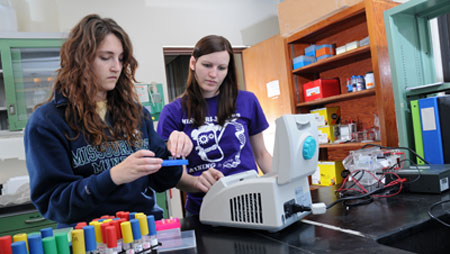Student team’s glucose sensor uses DNA instead of chemicals
Posted by Andrew Careaga
People with diabetes may one day have a less expensive resource for monitoring their blood glucose levels, if research by a group of Missouri University of Science and Technology students becomes reality.
Members of the Missouri S&T chapter of iGEM – the International Genetically Engineered Machine Foundation – recently devised a biological system that uses segments of DNA embedded in bacteria to detect glucose. The students believe their development could lead to a new type of test strip for diabetics.

Biological sciences students Erica Shannon, left, and Amanda Foster are among the members of Missouri S&T’s iGEM chapter. The group developed a biological system to detect glucose levels, a process that could one day help people with diabetes.
“We designed DNA so that bacteria that have DNA would sense a change in osmolarity due to the presence of glucose,” says Erica Shannon of Wildwood, Mo., a senior in biological sciences at Missouri S&T and president of the campus’s iGEM chapter. Osmolarity refers to the concentration of a compound – in this case, glucose – in a solution.
For their project, the students designed genes that allow the bacteria – a non-virulent strain of E. coli – to sense the presence of the simple sugar glucose. The bacteria emit a yellow glow when glucose is present. As glucose concentrations become higher, the glow becomes brighter.
The team developed the system as part of an annual competition sponsored by iGEM, the Americas Regional Jamboree, held Oct. 8-10, 2011, in Indianapolis. S&T’s iGEM chapter received a silver medal for their effort.
According to Shannon, her team’s biological system could form the basis for new, less costly processes to help people with diabetes monitor their blood-sugar levels. It would require replacing the fluorescent gene with one that would cause the bacteria to change color based on glucose levels. This in turn could lead to the development of diabetes blood-test strips that could indicate glucose levels based on various colors. For example, a test strip might turn green if glucose levels are within normal ranges, yellow if borderline and red if elevated.
“All you would have to do is put the DNA inside a bacteria and you’ve got your test strip,” says Shannon.
Bacteria-based test strips would also be less expensive to make than current chemical-based test strips, Shannon says.
“In the future, based on further research, an insulin gene could be added to this system for use in insulin pumps, where specific glucose levels trigger insulin production,” she says.
In addition to Shannon, other members of the iGEM team include:
- Amanda Foster of Jefferson City, Mo, a senior in biological sciences and biochemical engineering and chapter vice president.
- Blythe Ferriere of Sturgeon, Mo, a junior in chemical engineering and chapter treasurer.
- Brice Curtin of St. Louis, Mo, a senior in chemistry and chapter secretary.
- Lou Harmon of St. Louis, Mo, a senior in computer science and chapter webmaster.
- David Pohlman of Arnold, Mo, a junior in biochemical engineering and chapter lab manager.
- Alie Abele of Long Lane, Mo, a sophomore in environmental engineering.
- Erica McFarland of Rolla, Mo, a senior in biological sciences.
- Hannah Frye of Lee’s Summit, Mo., a biochemistry major.
- Beth Wilkins of Rolla, Mo, a junior in biological sciences and chemistry.
- Emily Puleo of St. Louis, Mo, a freshman in biochemistry.
- Logan Sauerbrei of Lebanon, Mo, a junior in biological sciences.
- Chester Gregg of Maryville, Mo, a junior in computer science and physics.
- Amber Kreps of St. James, Mo, a senior in biological sciences.
- Christy Kwon of Rolla, Mo, a student at Truman State University in Kirksville, Mo.
- Gavin Pringle of Cape Girardeau, Mo, a sophomore in computer science.
- Tyler Robinson of St. Louis, Mo, a senior in biological sciences.
- Thomas Congdon of St. Robert, Mo, a freshman in biological sciences.
The team advisors are Dr. David Westenberg and Dr. Katie Shannon, both associate professors of biological sciences at Missouri S&T.